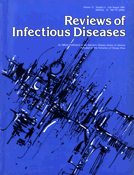-
Views
-
Cite
Cite
George A. DeVault, John W. King, Michael S. Rohr, Michael D. Landreneau, Stephen T. Brown, John C. McDonald, Opportunistic Infections with Strongyloides stercoralis in Renal Transplantation, Reviews of Infectious Diseases, Volume 12, Issue 4, July-August 1990, Pages 653–671, https://doi.org/10.1093/clinids/12.4.653
Close - Share Icon Share
Abstract
Opportunistic infections with the nematode Strongyloides stercoralis occur most often in patients with impaired T lymphocyte function, including recipients of renal allografts. Occult intestinal infection can remain quiescent for more than 30 years, becoming apparent only after the initiation of immunosuppression. Pulmonary and gastrointestinal symptoms predominate as initial clinical manifestations in patients with strongyloides hyperinfection or dissemination. Although thiabendazole remains the treatment of choice for all forms of strongyloidiasis, the duration of therapy must be individualized on the basis of frequent examinations of both stool and sputum. Transplantation centers drawing patients from areas with endemic Strongyloides should evaluate potential recipients closely for occult strongyloides infection prior to initiating immunosuppressive therapy. Empiric therapy with thiabendazole should be considered for renal allograft recipients with unexplained eosinophilia and a history of travel or residence in an area with endemic Strongyloides. Prophylactic monthly administration of thiabendazole in immunocompromised patients who have survived strongyloides hyperinfection or dissemination can prevent reinfection.
- renal transplantation
- lung
- eosinophilia
- feces
- immunocompromised host
- nematoda
- opportunistic infections
- signs and symptoms
- signs and symptoms, digestive
- sputum
- strongyloides
- strongyloides stercoralis
- strongyloidiasis
- thiabendazole
- t-lymphocytes
- travel
- therapeutic immunosuppression
- kidney
- transplantation
- intestinal infections
- allografting
- duration of treatment
- reinfection







Comments